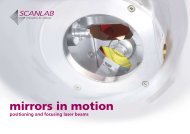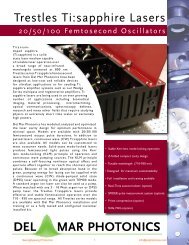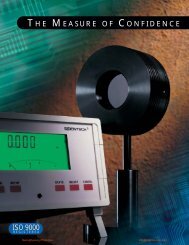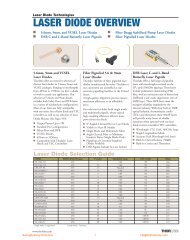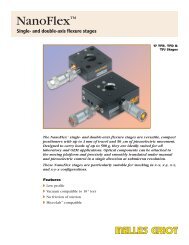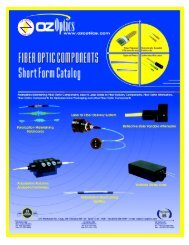DPSS Laser - 성경 포토닉스
DPSS Laser - 성경 포토닉스
DPSS Laser - 성경 포토닉스
- No tags were found...
Create successful ePaper yourself
Turn your PDF publications into a flip-book with our unique Google optimized e-Paper software.
PCEdu-1Photon Counting Fundamentals Educator PackInteractive Labs and Experiments: ContentsLab 1 - Modes of Operation: Objectives• Investigate the differences between the 3 modes of operation;photodiode (linear), avalanche and Geiger.Lab 2 - Photodiode Characteristics: Objectives• Measure current versus voltage for a photon counting detectorand plot the resulting current-voltage (I-V) characteristic.• Use the measured I-V characteristic to extract the photodiodeparameters.• Investigate the variation of dark count with temperature andexcess bias.Lab 3 - Photon Detection Probability: Objectives• Measure the photon detection probability (PDP) of a photoncounter.• Illustrate the variation in photon detection probability withwavelength.• Investigate the variation in photon detection probability withexcess bias.Lab 4 - Passive Quench Circuit Simulation: Objectives• Simulate a passive quench circuit.• Observe the effect of the load resistance on the total deadtime.• Investigate the impact of the photodiode parasitics on thedeadtime.Lab 5 - Active and Passive Photon Counting: Objectives• Observe the detector count rate achievable using anactive quench/reset circuit.• Observe the detector count rate achievable using apassive quench/reset circuit.• Compare active and passive photon counting.Detector Description and SpecificationsSensL’s Photon Counter is the first miniature photon counting system on the market. A complete photon counting devicein a T08 package mounted on a PCB. Featuring SensL’s new quenching architecture (patent pending) the device incorporatessnap on modules for enhanced functionality. The Photon Counter is the ideal solution for photon counting educationand training in educational establishments and OEMs.The sensing performance of silicon based photon counters typicallyApplicationsexceeds Photomultiplier Tube (PMT) values for key photon countingparameters, while its size is the perfect solution for applications where• Point-of-Use Sensorsportability, power supply, and power consumption are critical. The new • Point-of-Care Sensorsquenching architecture enables state of the art timing jitter and minimal • Fluorescence Lifetime Measurements (FLIM)after pulsing making it ideal for applications where timing resolution is • Biological Sensorsimportant. The device is hermetically sealed and the sensor is mounted• Scanning Microarrayson a Peltier cooler. Add-on modules are included to drive the Peltier so• DNA Biochips/Sequencingthat temperature variation experiments can be conducted and a USBport is provided for interfacing with a PC.The detector is based on new shallow junction Geiger-mode avalanchephotodiode technology. Several advantages in this detector structureover competing systems include increased sensitivity to blue-red wavelengths,increased response time (timing jitter) to fast optical signalsand low internal operating voltages. This increases sensitivity for criticalbiomedical applications and allows fast fluorescence decay signals tobe measured with unparalleled accuracy from an affordable compactunit. For full module specifications please refer to SensL’s PCDMinidatasheet (20µm specs).Note: SensL reserves the right to change all product specification and functionality without notification. Information on this datasheet is believed to be accurate, however,no responsibility is assumed for any inaccuracies or omissions.Feb 2008www.skphotonics.com 100 <strong>성경</strong><strong>포토닉스</strong>Page 3





